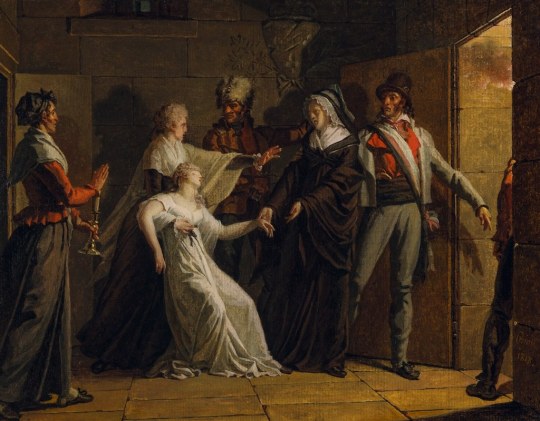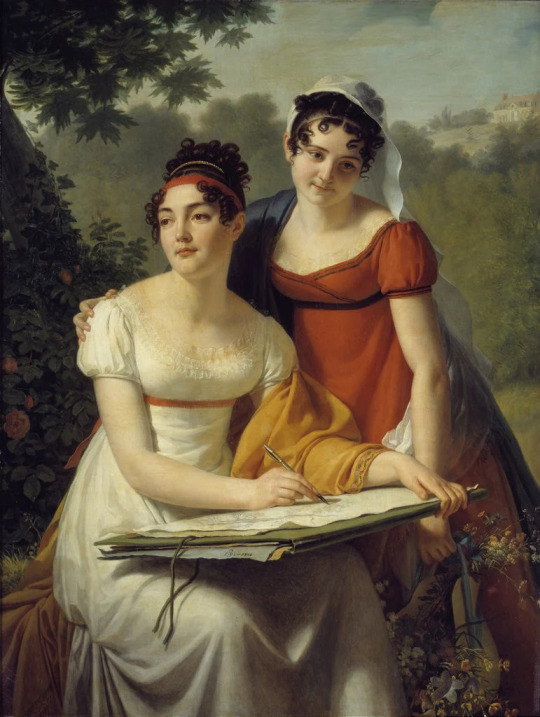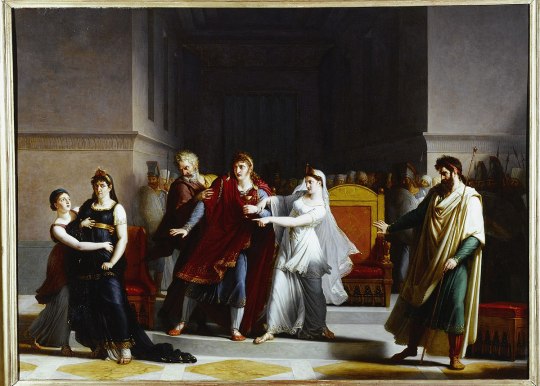#Jacques Augustin Pajou
Text

Jacques-Augustin-Catherine Pajou (French, 1766-1828)
Portraits des demoiselles Duval, 1814
Musée du Louvre
#duval sisters#Portraits des demoiselles Duval#Jacques-Augustin-Catherine Pajou#Jacques Augustin Pajou#french art#french#western civilization#art#fine art#european art#classical art#europe#european#oil painting#fine arts#female portrait#female#women in art#portrait#mediterranean#europa#brunette#women#black hair#france#classic art#traditional art
220 notes
·
View notes
Text

Mesdemoiselles Duval
Circa 1814
Napoleonic Era
Jacques Augustin Pajou (Paris, 1766 - Paris, 1828)
Source: Louvre Museum
#Mesdemoiselles Duval#Jacques Augustin Pajou#pajou#19th century#1814#1800s#Napoleonic era#first french empire#empire period#empire style#louvre#the louvre#France#Paris#portrait#painting#pretty#fashion#historical fashion#fashion history#empire#regency#early 1800s fashion#french empire#women#drawing#regency era#women’s art#art#regency fashion
19 notes
·
View notes
Text

Jacques Augustin Pajou - Marie Antoinette séparée de sa famille au temple - 1818
Marie Antoinette (Marie Antoinette Josèphe Jeanne; 2 November 1755 – 16 October 1793) was the last queen of France prior to the French Revolution. She was born an archduchess of Austria, and was the penultimate child and youngest daughter of Empress Maria Theresa and Emperor Francis I. She became dauphine of France in May 1770 at age 14 upon her marriage to Louis-Auguste, heir apparent to the French throne. On 10 May 1774, her husband ascended the throne as Louis XVI and she became queen.
As queen, Marie Antoinette became increasingly unpopular among the people; the French libelles accused her of being profligate, promiscuous, having illegitimate children, and harboring sympathies for France's perceived enemies, including her native Austria. She was falsely accused in the Affair of the Diamond Necklace, but the accusations damaged her reputation further. During the French Revolution, she became known as Madame Déficit because the country's financial crisis was blamed on her lavish spending and her opposition to social and financial reforms proposed by Anne Robert Jacques Turgot and Jacques Necker.
Several events were linked to Marie Antoinette during the Revolution after the government placed the royal family under house arrest in the Tuileries Palace in October 1789. The June 1791 attempted flight to Varennes and her role in the War of the First Coalition were immensely damaging to her image among French citizens. On 10 August 1792, the attack on the Tuileries forced the royal family to take refuge at the Assembly, and they were imprisoned in the Temple Prison on 13 August. On 21 September 1792, the monarchy was abolished. Louis XVI was executed by guillotine on 21 January 1793. Marie Antoinette's trial began on 14 October 1793; she was convicted two days later by the Revolutionary Tribunal of high treason and executed, also by guillotine, at the Place de la Révolution.
Jacques-Augustin-Catherine Pajou (27 August 1766, Paris - 28 November 1828, Paris) was a French painter in the Classical style.
12 notes
·
View notes
Note
Hi! This is purely out of reaction to that Napoleonic portrait with the carrick coat and bc I recently started following (and enjoying) your blog, but is there any chance you know the name of this kind of toga-like cloak from the late 1790s? I drew one recently from a bunch of painting references but haven't been able to associate a term.


These are 1798 Louis-Léopold Boilly - Artists in Isabey's Studio and 1798 Jacques-Augustin-Catherine Pajou - Portrait of a family respectively
Either way, love your commentary on 18th-19th century fashions!
Hello, and my apologies for taking forever to answer this!! I didn't forget about this ask, I just didn't feel like I had a satisfactory answer.
As far as I can tell, these are both examples of a loose-fitting greatcoat or cloak. It feels anachronistic in an era when men's coats are getting a lot tighter and more fitted, but 1800ish men still had billowing cloaks and greatcoats (sometimes).

Men's long greatcoat of 1809-1810 at centre, from Handbook of English Costume in the 19th Century by Phillis and C. Willett Cunnington.
The same source describes men's overcoats of the period 1800 to 1810:
THE BOX COAT was a very large and loose great coat with one or more capes. Originally a driving-coat for wearing on the box of a coach this came to be worn, in cold weather, even on foot. [...]
THE CLOAK was not in fashion though often worn when travelling on the outside of a coach. It was very long and usually fastened by straps down the front.
The Dictionary of Fashion History by Valerie Cumming dates box coats to the late 18th century, so that's one possible answer.
#fashion history#dress history#asks#1790s#historical men's fashion#1810s#1800s#thank you for the ask!#sorry i couldn't be of more help#coats#cloaks
14 notes
·
View notes
Text

“Academic male study”, c.1785 by Jacques Augustin Cathérine Pajou (1766–1828). French classical painter. Nationalmuseum, Stockholm. oil on canvas
86 notes
·
View notes
Text
• Una de las óperas más hermosas del mundo es sin duda la ópera real de Versalles. Es el teatro y ópera principal del Palacio de Versalles, en Francia. Diseñado por Ange-Jacques Gabriel y con una decoración de interiores de Augustin Pajou, la ópera fue construida totalmente de madera y pintada para parecer mármol con una técnica conocida como falso mármol.

• Panorámica dónde se encuentra en Francia 👆 (Europa), el Palacio de Versailles.
• El edificio está ubicado en el extremo norte del ala de los nobles. El acceso del público general al teatro es a través del vestíbulo de dos pisos. Algunas partes de la ópera, tales como los aposentos del rey, representan una de las primeras expresiones de lo que se convertiría en el «estilo Luis XVI»
• El Persée de Jean-Baptiste Lully —escrita en 1682, el año en que Luis XIV se mudó al palacio— inauguró la ópera el 16 de mayo de 1770 en celebración del matrimonio del delfín —el futuro Luis XVI— con María Antonieta.
• La ópera real puede servir tanto como un teatro para ópera, piezas teatrales u orquesta (con una capacidad para 712 personas), así como una salle des festins, cuando el piso del nivel de la orquesta del auditorio puede ser alzado al nivel del escenario. En estas ocasiones, la ópera tiene una capacidad para 1.200 personas.
🎷🎼🎻𝅘𝅥𝅰𝅘𝅥𝅮🎺♫
Vídeo por Antoine.
Música del vídeo, Max Richter - Las nuevas cuatro estaciones - Vivaldi recompuesto: primavera 1.
#chateaudeversailles#versailles#royal palace#palace#royal style#ópera#architecture#heritage#art history#luxury#french aristocracy#18th century#elegancia#elegance
59 notes
·
View notes
Text


Jacques Augustin Cathérine Pajou
Male Studies
Nationalmuseet, Stockholm
5 notes
·
View notes
Photo

Jacques Augustin Pajou - Ariadne abandoned, 1796.
2 notes
·
View notes
Photo

Mercury by Jacques-Augustin Pajou (18th Century)
#augustin pajou#art#sculpture#statue#fine art#18th century#18th century art#neoclassical#neoclassical art#neoclassicism#french art#french artist#mythology#roman mythology#roman god#mercury#hermes#marble sculpture#classic art#jacques-augustin pajou
576 notes
·
View notes
Photo

1809 Jacques-Augustin-Catherine Pajou - Portrait of a gentleman in a grey coat, half-length
(Private collection via Christie's)
84 notes
·
View notes
Photo

Jacques-Augustin-Catherine Pajou (French, 1766-1828)
Duval sisters, 1814
Musée du Louvre
#Jacques-Augustin-Catherine Pajou#art#fine art#french art#french#france#duval sisters#Jacques Augustin Catherine Pajou#french girls#european#brunette#female portrait#19th century#classical art#europe#beautiful art
33 notes
·
View notes
Text

Jacques-Augustin-Catherine Pajou
Dernière scène de la tragédie "Rodogune" au Théâtre-Français
Detail, c. 1810
#Jacques-Augustin-Catherine Pajou#pajou#napoleonic era#19th century#French art#French#art#1810#1800s#Napoleonic#France#classical#neoclassical#neoclassical art#neoclassicism#antiquity#classical antiquity#pretty#Greece#Ancient Greece#ancient Rome#greek mythology#Greek myths#myths#mythology#theater#detail#first french empire#french empire#tragedy
63 notes
·
View notes
Text

Jacques-Augustin Pajou - Dernière scène de la tragédie "Rodogune" au Théâtre-Français - 1810
height: 120 cm (47.2 in) Edit this at Wikidata; width: 162 cm (63.7 in)
Musée Carnavalet, Musée de la Ville de Paris, France
Jacques-Augustin-Catherine Pajou (27 August 1766, Paris - 28 November 1828, Paris) was a French painter in the Classical style.
13 notes
·
View notes
Text

Portrait of Marshal Berthier, attributed to Jacques-Augustin-Catherine Pajou.
#Louis-Alexandre Berthier#art#paintings#Jacques-Augustin-Catherine Pajou#19th century#Napoleon’s marshals
15 notes
·
View notes
Photo

Geta Dying in His Mother’s Arms, Jacques Pajou (1766-1828)
#art#art history#Jacques Pajou#Jacques Augustin Catherine Pajou#historical painting#ancient history#Ancient Rome#Roman Empire#Severan Dynasty#Caracalla#Geta#Julia Domna#French art#18th century art#19th century art#Staatsgalerie Stuttgart#violence tw#death tw
300 notes
·
View notes
Photo



Cupid and Psyche, 1798, by François Gérard (1770-1837)
François Gérard (1770-1837)
Having worked in studios under the tutelage of prominent artists such as Augustin Pajou (1730-1809) and Jacques-Louis David (1748-1825), it’s no wonder François Gérard himself would later become one of the most fashionable Neoclassical artists in Paris. Initially an illustrator for literature, he would later become known as a master in creating some of history’s most beautiful propaganda.
Gérard’s patrons were involved in the court of Napoleon Bonaparte (1769-1821), and of course included Napoleon Bonaparte himself. Many recognised his talents, and so Gérard became a (let’s say somewhat accurate) visual interpreter for the French Empire. As Kathryn Calley Galitz states in ‘François Gérard: Portraiture, Scandal, and the Art of Power in Napoleonic France,’ his portraits are so well known as they “epitomize the allure of portraiture as a means of self-promotion in Napoleonic France, especially in the hands of such a master as François Gérard.”
Needless to say, Gérard was considered a genius. His portrait of Josephine Bonaparte (1763-1814) was hailed a masterpiece, and his work was compared to the likes of Leonardo da Vinci. An ingredient to his success was in part due to the rising popularity of portraiture, a real obsession for it began to emerge within French society at this time, much to the dismay of more traditional critics. Many lamented at having to view the faces of such unknowns “bereft of… talent” in a setting so prestigious as the Salons. While not always a critical success, Gérard was certainly a commercial one, and was intent to further push this trend.
While most recognised for his portraiture, Gérard also had a strong passion for the genre of history painting, which was considered the more respectable of the two. He later on seemed to have expressed disappointment for letting his portraits distract him from this. However, his work has cemented his place within history.
#Cupid and Psyche#art#art history#information#french art#french#fra#artist#François Gérard#Jacques-Louis David#art history blog#artwork#painting#painter#Bonaparte#Napoleon Bonaparte#neoclassical#neoclassicism#neoclassical artist#portrait#history#1700's#18th century#1700s#1800's#1800s
629 notes
·
View notes